Radiation/Meteors

Particle radiation upwards in size above that of atomic nuclei may be lumped together as meteor radiation.
As an example, there is the image on the right.
"The invisible cloud is plummeting toward our galaxy at nearly 700,000 miles per hour."[1]
"This composite image shows the size and location of the Smith Cloud on the sky. The cloud appears in false-color, radio wavelengths as observed by the Green Bank Telescope in West Virginia. The visible-light image of the background star field shows the cloud's location in the direction of the constellation Aquila."[1]
"Though hundreds of enormous, high-velocity gas clouds whiz around the outskirts of our galaxy, this so-called “Smith Cloud” is unique because its trajectory is well known. New Hubble observations suggest it was launched from the outer regions of the galactic disk, around 70 million years ago. The cloud was discovered in the early 1960s by doctoral astronomy student Gail Smith, who detected the radio waves emitted by its hydrogen."[1]
"Hubble Space Telescope measurements show that the cloud came out of a region near the edge of the galaxy's disk of stars 70 million years ago. The cloud is now stretched into the shape of a comet by gravity and gas pressure. Following a ballistic path, the cloud will fall back into the disk and trigger new star formation 30 million years from now."[1]
"Astronomers have measured this comet-shaped region of gas to be 11,000 light-years long and 2,500 light-years across. If the cloud could be seen in visible light, it would span the sky with an apparent diameter 30 times greater than the size of the full moon."[1]
"The astronomers found that the Smith Cloud is as rich in sulfur as the Milky Way’s outer disk, a region about 40,000 light-years from the galaxy’s center (about 15,000 light-years farther out than our sun and solar system). This means that the Smith Cloud was enriched by material from stars. This would not happen if it were pristine hydrogen from outside the galaxy, or if it were the remnant of a failed galaxy devoid of stars. Instead, the cloud appears to have been ejected from within the Milky Way and is now boomeranging back."[1]
Theoretical meteor radiation
[edit | edit source]For this resource, a theoretical definition to handle all sizes of radiated meteors is proposed.
Here's that theoretical definition:
Def. "any natural object radiating through a portion or all of the Earth's or another natural, astronomical object's atmosphere"[2] is called a meteor.
These are usage notes:
- Such an object may be as small as an electron or much larger.
- Astronomical objects that are atoms, nuclei, or subatomic particles are part of cosmic-ray astronomy.
- Astronomical objects larger than atoms, nuclei, or subatomic particles that are fast-moving relative to perceived, almost motionless objects, radiating through another natural object's atmosphere or gaseous environment are also here referred to as meteors.
- These can be a high-velocity star moving through the interstellar medium or a larger object moving through an intergalactic medium.
- At the extreme a meteor can be a galaxy cluster moving relative to apparently stationary clusters in its neighborhood of the universe.
High-velocity galaxies
[edit | edit source]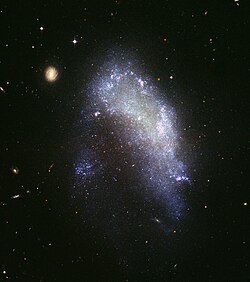
"The irregular galaxy NGC 1427A is a spectacular example of the resulting stellar rumble. Under the gravitational grasp of a large gang of galaxies, called the Fornax cluster, the small bluish galaxy is plunging headlong into the group at 600 kilometers per second or nearly 400 miles per second."[3]
"Galaxy clusters, like the Fornax cluster, contain hundreds or even thousands of individual galaxies. Within the Fornax cluster, there is a considerable amount of gas lying between the galaxies. When the gas within NGC 1427A collides with the Fornax gas, it is compressed to the point that it starts to collapse under its own gravity. This leads to formation of the myriad of new stars seen across NGC 1427A, which give the galaxy an overall arrowhead shape that appears to point in the direction of the galaxy's high-velocity motion."[3]
Hypervelocity stars
[edit | edit source]


"To date, all of the reported hypervelocity stars (HVSs), which are believed to be ejected from the Galactic center, are blue and therefore almost certainly young.”[4]
Def. a high-velocity star moving through space with an abnormally high velocity relative to the surrounding interstellar medium is called a runaway star.
"Of particular importance has been access to high resolution R~40,000-100,000 echelle spectra providing an ability to study the dynamics of hot plasma and separate multiple stellar and interstellar absorption components."[5]
At left is a radiated object, the binary star Mira, and its associated phenomena.
Ultra-violet studies of Mira by NASA's Galaxy Evolution Explorer (Galex) space telescope have revealed that it sheds a trail of material from the outer envelope, leaving a tail 13 light-years in length, formed over tens of thousands of years.[6][7] It is thought that a hot bow-wave of compressed plasma/gas is the cause of the tail; the bow-wave is a result of the interaction of the stellar wind from Mira A with gas in interstellar space, through which Mira is moving at an extremely high speed of 130 kilometres/second (291,000 miles per hour).[8][9] The tail consists of material stripped from the head of the bow-wave, which is also visible in ultra-violet observations. Mira's bow-shock will eventually evolve into a planetary nebula, the form of which will be considerably affected by the motion through the interstellar medium (ISM).[10]
At second right is the only available X-ray image, by the Chandra X-ray Observatory, of Mira A on the right and Mira B (left). "Mira A is losing gas rapidly from its upper atmosphere [apparently] via a stellar wind. [Mira B is asserted to be a white dwarf. In theory] Mira B exerts a gravitational tug that creates a gaseous bridge between the two stars. Gas from the wind and bridge accumulates in an accretion disk around Mira B and collisions between rapidly moving particles in the disk produce X-rays."[11]
Mira A, spectral type M7 IIIe[12], has an effective surface temperature of 2918–3192[13]. Mira A is not a known X-ray source according to SIMBAD, but here is shown to be one.
High-velocity stars
[edit | edit source]
"In 1988, the first evidence for a black hole at the exact center of M31 came from ground-based observations by Dr. John Kormendy (now at the University of Hawaii), and independently by Dr. Alan Dressler (Observatories of the Carnegie Institution of Washington), and Dr. Douglas O. Richstone (University of Michigan). Their data indicated an abrupt increase in the orbital velocities of stars in the center of the M31 nucleus."[14]
High-velocity clouds
[edit | edit source]
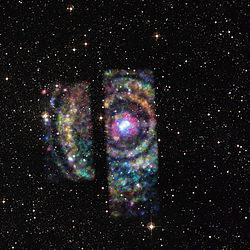
"A large spiral galaxy, with its nucleus still intact, peers at the smaller passing galaxy (nearly out of the field of view at lower right), while a bright blue beak and bright whitish-blue top feathers show the distinct path taken during the smaller galaxy's journey. These galaxies did not merely interact gravitationally as they passed one another, they actually collided."[15]
The "situation is quite different for the interstellar media in the above two galaxies - material consisting largely of clouds of atomic and molecular gases and of tiny particles of matter and dust, strongly coupled to the gas. Wherever the interstellar clouds of the two galaxies collide, they do not freely move past each other without interruption but, rather, suffer a damaging collision. High relative velocities cause ram pressures at the surface of contact between the interacting interstellar clouds. This pressure, in turn, produces material densities sufficiently extreme as to trigger star formation through gravitational collapse. The hot blue stars in this image are evidence of this star formation."[15]
"Circinus X-1 is [in the image on the left] the source of a surprisingly powerful jet of high-energy particles."[16]
The "rings are echoes from a burst of X-rays emitted by Circinus X-1 in late 2013. The burst reflected off intervening clouds of dust, with some reflected X-rays arriving to Earth from different angles at a time delay of about one to three months, creating the observed rings."[16]
Each "ring was created by the X-ray reflections off a different dust cloud."[16]
"These rings can be seen in the composite image where X-rays from Chandra are red, green, and blue corresponding to low, medium, and high-energy X-rays respectively, which have been combined with a view in visible light [Gold] from the Digitized Sky Survey. The sharp edges are caused by the large size of the X-ray rings compared to the relatively small field-of-view of the Chandra detectors, providing only partial coverage."[16]
The "speed of the jet of high-energy particles produced by the system is at least 99.9% of the speed of light."[16]
Volcanic clouds
[edit | edit source]
The mushroom-shaped plume in the image on the right rose from avalanches of hot debris that cascaded down the north flank, when Mount Redoubt erupted on April 21, 1990.
"Redoubt Volcano is a steep-sided cone about 10 km in diameter at its base and with a volume of 30-35 cubic kilometers. The volcano is composed of intercalated pyroclastic deposits and lava flows and rests on Mesozoic granitic rocks of the Alaska-Aleutian Range batholith (Till and others, 1993; 1994). It has been moderately dissected by the action of numerous alpine glaciers. A 1.8-km-wide, ice-filled summit crater is breached on the north side by a northward-flowing glacier, informally known as the Drift Glacier, which spreads into a piedmont lobe in the upper Drift River Valley. The most recently active vent is located on the north side of the crater at the head of the Drift glacier. Holocene lahar deposits in the Crescent River and Drift River valleys extend downstream as far as Cook Inlet."[17]
Clouds
[edit | edit source]
Def. a visible mass of
- water droplets suspended in the air,
- dust,
- steam,
- smoke,
- a group or swarm is called a cloud.
Clouds have been observed on other planets and moons within the Solar System, but, due to their different temperature characteristics, they are composed of other substances such as methane, ammonia, and sulfuric acid.
Clouds act as electric insulators; space charge develops on the surface of the cloud and the distribution of fair-weather currents and fields in the vicinity of the cloud are altered.
The "electrical environment around clouds is such that high space charge densities can exist."[18]
Cumulonimbuses
[edit | edit source]
A "thunderstorm supplies a negative charge to the Earth. The net positive space charge in the air between the ground and a height of ~ 10 km is nearly equal to the negative charge on the Earth's surface".[19]
'Giant' "thunderclouds can produce transverse electric fields of tens of microvolts per meter in the equatorial plane of the midlatitude magnetosphere."[20]
The "contribution to global thunderstorm activity by oceanic thunderstorms should be regarded as itself having a diurnal variation of some 18% in amplitude."[21]
Molecular clouds
[edit | edit source]
In the image at right is a molecular cloud of gas and dust that is being reduced. "Likely, within a few million years, the intense light from bright stars will have boiled it away completely. The cloud has broken off of part of the Carina Nebula, a star forming region about 8000 light years away. Newly formed stars are visible nearby, their images reddened by blue light being preferentially scattered by the pervasive dust. This image spans about two light years and was taken by the orbiting Hubble Space Telescope in 1999."[22]
A molecular cloud, sometimes called a stellar nursery if star formation is occurring within, is a type of interstellar cloud whose density and size permit the formation of molecules, most commonly molecular hydrogen (H2).
Molecular hydrogen is difficult to detect by infrared and radio observations, so the molecule most often used to determine the presence of H2 is CO (carbon monoxide). The ratio between CO luminosity and H2 mass is thought to be constant, although there are reasons to doubt this assumption in observations of some other galaxies.[23]
Such clouds make up < 1% of the ISM, have temperatures of 10-20 K and high densities of 102 - 106 atoms/cm3. These clouds are astronomical radio and infrared sources with radio and infrared molecular emission and absorption lines.
Giant molecular clouds
[edit | edit source]A vast assemblage of molecular gas with a mass of approximately 103–107 times the mass of the Sun[24] is called a giant molecular cloud (GMC). GMCs are ≈15–600 light-years in diameter (5–200 parsecs).[24] Whereas the average density in the solar vicinity is one particle per cubic centimetre, the average density of a GMC is 102–103 particles per cubic centimetre. Although the Sun is much denser than a GMC, the volume of a GMC is so great that it contains much more mass than the Sun. The substructure of a GMC is a complex pattern of filaments, sheets, bubbles, and irregular clumps.[25]
The densest parts of the filaments and clumps are called "molecular cores", whilst the densest molecular cores are, unsurprisingly, called "dense molecular cores" and have densities in excess of 104–106 particles per cubic centimeter. Observationally molecular cores are traced with carbon monoxide and dense cores are traced with ammonia. The concentration of dust within molecular cores is normally sufficient to block light from background stars so that they appear in silhouette as dark nebulae.[26]
GMCs are so large that "local" ones can cover a significant fraction of a constellation; thus they are often referred to by the name of that constellation, e.g. the Orion Molecular Cloud (OMC) or the Taurus Molecular Cloud (TMC). These local GMCs are arrayed in a ring in the neighborhood of the Sun coinciding with the Gould Belt.[27] The most massive collection of molecular clouds in the galaxy forms an asymmetrical ring around the galactic center at a radius of 120 parsecs; the largest component of this ring is the Sagittarius B2 complex. The Sagittarius region is chemically rich and is often used as an exemplar by astronomers searching for new molecules in interstellar space.[28]
Chamaeleon I dark clouds
[edit | edit source]
The Chamaeleon I (Cha I) cloud is a coronal cloud and one of the nearest active star-forming regions at ~160 pc.[29] It is relatively isolated from other star-forming clouds, so it is unlikely that older pre-main sequence (PMS) stars have drifted into the field.[29] The total stellar population is 200-300.[29] The Cha I cloud is further divided into the North cloud or region and South cloud or main cloud.
Chamaeleon II dark clouds
[edit | edit source]"The Chamaeleon II dark cloud contains some 40 X-ray sources.[30] Observation in Chamaeleon II was carried out from September 10 to 17, 1993.[30] Source RXJ 1301.9-7706, a new WTTS candidate of spectral type K1, is closest to 4U 1302-77.[30]
Chamaeleon III dark clouds
[edit | edit source]Chamaeleon III appears to be devoid of current star-formation activity."[31] "HD 104237 (spectral type A4e) observed by [the Advanced Satellite for Cosmology and Astrophysics (ASCA)], located in the Chamaeleon III dark cloud, is the brightest Herbig Ae/Be star in the sky.[32]
Aerometeors
[edit | edit source]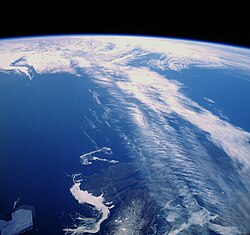
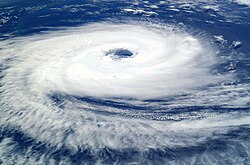
Def. a discrete unit of air, wind, or mist traveling or falling through or partially through an atmosphere is called an aerometeor.
Def. any of the high-speed, high-altitude air currents that circle the Earth in a westerly direction is called a jet stream.
Def. a system of winds rotating around a center of low atmospheric pressure, the more or less violent small-scale circulations such as tornadoes, waterspouts, and dust devils is called a cyclone.
At left is an image of the cyclone Catarina.
Plasma meteors
[edit | edit source]
A magnetic cloud is a transient event observed in the solar wind. It was defined in 1981 by Burlaga et al. 1981 as a region of enhanced magnetic field strength, smooth rotation of the magnetic field vector and low proton temperature [33]. Magnetic clouds are a possible manifestation of a Coronal Mass Ejection (CME). The association between CMEs and magnetic clouds was made by Burlaga et al. in 1982 when a magnetic cloud was observed by Helios-1 two days after being observed by SMM[34]. However, because observations near Earth are usually done by a single spacecraft, many CMEs are not seen as being associated with magnetic clouds. The typical structure observed for a fast CME by a satellite such as ACE is a fast-mode shock wave followed by a dense (and hot) sheath of plasma (the downstream region of the shock) and a magnetic cloud.
Other signatures of magnetic clouds are now used in addition to the one described above: among other, bidirectional superthermal electrons, unusual charge state or abundance of iron, helium, carbon and/or oxygen. The typical time for a magnetic cloud to move past a satellite at the L1 point is 1 day corresponding to a radius of 0.15 AU with a typical speed of 450 km s−1 and magnetic field strength of 20 nT [35]
Def. a massive burst of solar wind, other light isotope plasma, and magnetic fields rising above the solar corona or being released into space is called a coronal mass ejection (CME).
Coronal clouds
[edit | edit source]A coronal cloud is a cloud, or cloud-like, natural astronomical entity, composed of plasma and usually associated with a star or other astronomical object where the temperature is such that X-rays are emitted. While small coronal clouds are above the photosphere of many different visual spectral type stars, others occupy parts of the interstellar medium (ISM), extending sometimes millions of kilometers into space, or thousands of light-years, depending on the size of the associated object such as a galaxy.
"This energy [1032 to 1033 ergs] appears in the form of electromagnetic radiation over the entire spectrum from γ-rays to radio burst, in fast electrons and nuclei up to relativistic energies, in the creation of a hot coronal cloud, and in large-scale mass motions including the ejections of material from the Sun."[36]
Def. the luminous plasma atmosphere of the Sun or other star, extending millions of kilometres into space, most easily seen during a total solar eclipse is called a corona, or stellar corona.
"Coronal clouds are irregular objects suspended in the corona with matter streaming out of them into nearby active regions."[37]
Lightnings
[edit | edit source]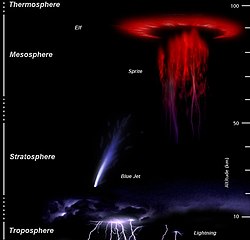
The temperature for a lightning bolt channel is 28 kK or 28,000 K with a peak emittance wavelength of black-body radiation at approximately 100 nm (far ultraviolet light).
Sprites
[edit | edit source]"During a thunderstorm, high in the ionosphere, you’ll find an odd variety of lightning that is far above the thunderstorm itself. Jellyfish lightning, also known as sprites, are red flashes of light that last for a few seconds. They can have a wide bell-shaped top and tentacle-like wisps of light at the bottom, resembling a jellyfish."[38]
"In high-speed videos we can see the dynamics of sprite formation and then use that information to model and to reproduce the dynamics."[39]
"These sprites only occur during thunderstorms, though sprites are about three times higher up than storms. [...] the storms are necessary for sprites to occur, they aren’t quite sufficient enough to cause them on their own [...] The tentacle-like tendrils at the bottom were shown to form much faster than the bell-shaped top. [...] localized plasma irregularities can spark the formation of a sprite."[38]
Solar winds
[edit | edit source]"The sun spits out charged particles that hit our atmosphere two to four days later at 1.5-2.7 million kph, but it does not do so evenly."[40]
"The solar wind is not continuous, it has slow and fast streams. Because the Sun rotates, these streams can be sent out behind each other - so if you have a fast solar wind catching up with a slow solar wind, it causes a concentration to occur."[41]
"The slow phase is composed similarly to the solar corona while fast particles have a composition close to that of the photosphere, the outer layer of the sun that produces the light."[40]
There is "a 31% increase in average lightning strikes over central England (422 to 321) in the 40 days after major solar wind events compared to the days beforehand. Lightning peaked 12-18 days after the wind's arrival. A matching increase in thundery days provided supporting evidence."[40]
"It's unexpected, because these streams of particles bring with them an enhanced magnetic field - and this shields Earth from the very high-energy cosmic rays from outside of the Solar System.”[41]
"The reduction in cosmic rays is only around 1%, but still noticeable. Cosmic rays emitted by supernovae are thought to trigger lighting strikes, and it was expected that the shielding effect of the solar wind would cause a reduction in lightning, rather than an increase."[40]
Sunspot "numbers negatively correlate with thunder days in other parts of the world."[40]
"High speed streams were found to occur after periods when the sun was putting out less light, but sunspot numbers increased. Scott and his fellow authors attribute this to the streams coming from an active region appearing on the eastern side of the sun."[40]
"We propose that these particles, while not having sufficient energies to reach the ground and be detected there, nevertheless electrify the atmosphere as they collide with it, altering the electrical properties of the air and thus influencing the rate or intensity at which lightning occurs."[41]
Gigantic jets
[edit | edit source]
On February 02, 2014, the Oro Verde Observatory (República Argentina) reported 10 or more gigantic jet event[s] observed over a thunderstorm in Entre Ríos south. Storm center [is] located at 33°S, 60°W, near the Rosario city.
Each gigantic "jet could transfer 30 coulombs of negative charge from the clouds to the ionosphere (H T Su et al. 2003 Nature 423 974)."[42]
"During a thunderstorm in the South China Sea in July 2002, Su and co-workers used low-light-level cameras to photograph the clouds every 17 milliseconds. The five jets they observed - dubbed carrot-jets or tree-jets according to their shapes - were visible for some tens of milliseconds. But crucially, the team also detected simultaneous bursts of radio waves in four of the five cases, which indicates that the jets had transferred significant amounts of charge. The thunderclouds were at an altitude of 16 km."[42]
"Such electromagnetic bursts have only previously been linked with powerful lightning strikes, which are known to transfer large quantities of charge. But [lightning may not have] triggered the radio waves they detected, since the local lightning detection network registered no strikes at the times of the jets."[42]
On the left is an image of a fully developed gigantic jet above a thunderstorm near the Philippine.
Filaments
[edit | edit source]"This solar filament, some 350,000 kilometres long, erupted from the surface of the Sun on 31 August. Seen in the extreme ultraviolet by NASA’s Solar Dynamics Observatory satellite, the eruption became a coronal mass ejection moving at about 1,400 kilometres per second — its particles grazed Earth’s magnetosphere several days later, sparking an auroral display."[43]
Rays
[edit | edit source]
The image on the right suggests that the closer the observer is to being directly underneath the aurora the more it looks like radiation spraying down. The more distant from being directly below the more the aurora looks like ribbons.
The image on the left is from a location within the auroral oval where it frequently appears directly overhead.
Gaseous meteors
[edit | edit source]Gaseous objects have at least one chemical element or compound present in the gaseous state. These gaseous components make up at least 50 % of the detectable portion of the gaseous object. Atmospheric astronomy determines whether gaseous objects have layers or spherical portions predominantly composed of gas.
Within these spherical portions may occur various gaseous meteors such as clouds, winds, or streams.
Interstellar clouds
[edit | edit source]"Carbon monoxide is the second most abundant molecule, after H2, in interstellar clouds. In diffuse clouds, the amount of CO is mainly derived from measurements of absorption at UV wavelengths."[44]
Lyman-alpha blob
[edit | edit source]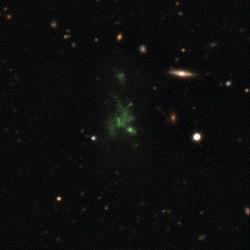
A Lyman-alpha blob (LAB) is a huge concentration of a gas emitting the Lyman-alpha emission line. LABs are some of the largest known individual objects in the Universe. Some of these gaseous structures are more than 400,000 light years across. So far they have only been found in the high-redshift universe because of the ultraviolet nature of the Lyman-alpha emission line. Since the Earth's atmosphere is very effective at filtering out UV photons, the Lyman-alpha photons must be redshifted in order to be transmitted through the atmosphere.
Beaming gases
[edit | edit source]"These images [at right] both depict the same area - the region of ionized gas around the nucleus of the bright Seyfert galaxy NGC 4151. In one case, the observations used a narrow-band filter to isolate the bright gaseous emission of doubly ionized oxygen - [O III] - at 5007 Angstroms, while the other used a diffraction grating to spread the light at each point into a spectrum. The color coding was used to indicate this and to show the direction of spectral dispersion, though the wavelength range spanned by the observation would not produce a vivid color range visually. The brilliant nucleus is spread into a horizontal line, producing radiation at all wavelengths in the form of a continuum. In the dispersed image, a single cloud of gas with small internal motions will have a single Doppler shift, and will have the same appearance as in the filtered image, perhaps with a position shift due to its overall Doppler shift with respect to the average. However, a parcel of gas with a large velocity dispersion, such as one might see in a turbulent situation or near a shock front, will be preferentially smeared along the wavelength direction (left-right in this depiction). Careful comparison of these two images shows that there are many such regions, mostly located in the locations close to where the galaxy's small radio jets emerge from the nucleus. These radio jets lie approximately along the axes of the twin emission-line cones. This connection between rapid local gas motions and the emerging jets has been interpreted as evidence that much of the "turbulent" motion in the outer regions of Seyfert nuclei is powered by the radio jets, as they transfer energy to their surroundings."[45]
"The emission-line image shows clearly the biconical region where most of the ionized gas appears, in support of a `beaming picture" for the various kinds of Seyfert nuclei. It poses an interesting puzzle, however, because to get this plan view we must be outside the cones, but we see the broad-line region and thus classify NGC 4151 as a type 1 Seyfert - in fact, it was the prototype of the class. Thus, there are directions outside these cones where we can have a fairly clear view of the core, so the simple mental picture of a solid torus and clear views along its axis cannot be taken quite literally."[45]
Liquid meteors
[edit | edit source]
Liquid water precipitation falls from the atmosphere and reaches the ground, such as drizzle and rain. Suspended liquid water particles may form and remain suspended in the air (damp haze, cloud, fog, and mist), or may be lifted by the wind from the Earth’s surface (blowing spray) causing restrictions to visibility.[46]
Sea levels
[edit | edit source]
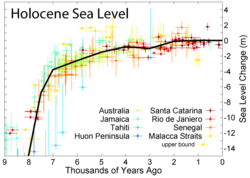

Mean sea level (MSL) is a measure of the average height of the ocean's surface (such as the halfway point between the mean high tide and the mean low tide); used as a standard in reckoning land elevation.[47] MSL also plays an extremely important role in aviation, where standard sea level pressure is used as the measurement datum of altitude at flight levels.
The upper figure at right shows the change in annually averaged sea level at 23 geologically stable tide gauge sites with long-term records as selected by Douglas (1997). The thick dark line is a three-year moving average of the instrumental records. This data indicates a sea level rise of ~27.5 cm from 1800-2000. Because of the limited geographic coverage of these records, it is not obvious whether the apparent decadal fluctuations represent true variations in global sea level or merely variations across regions that are not resolved.
For comparison, the recent annually averaged satellite altimetry data [1] from TOPEX/Poseidon are shown in red. These data indicate a somewhat higher rate of increase than tide gauge data, however the source of this discrepancy is not obvious. It may represent systematic error in the satellite record and/or incomplete geographic sampling in the tide gauge record. The month to month scatter on the satellite measurements is roughly the thickness of the plotted red curve.
The second figure at the right shows changes in sea level during the Holocene, the time following the end of the most recent glacial period, based on data from Fleming et al. 1998, Fleming 2000, & Milne et al. 2005. These papers collected data from various reports and adjusted them for subsequent vertical geologic motions, primarily those associated with post-glacial continental and hydroisostatic rebound. The first refers to deformations caused by the weight of continental ice sheets pressing down on the land, the latter refers to uplift in coastal areas resulting from the increased weight of water associated with rising sea levels. It should be noted that because of the latter effect and associated uplift, many islands, especially in the Pacific, exhibited higher local sea levels in the mid Holocene than they do today. Uncertainty about the magnitude of these corrections is the dominant uncertainty in many measurements of Holocene scale sea level change.
The black curve is based on minimizing the sum of squares error weighted distance between this curve and the plotted data. It was constructed by adjusting a number of specified tie points, typically placed every 1 kyr and forced to go to 0 at the modern day. A small number of extreme outliers were dropped. It should be noted that some authors propose the existence of significant short-term fluctuations in sea level such that the sea level curve might oscillate up and down about this ~1 kyr mean state. Others dispute this and argue that sea level change has been a smooth and gradual process for essentially the entire length of the Holocene. Regardless of such putative fluctuations, evidence such as presented by Morhange et al. (2001) suggests that in the last 10 kyr sea level has never been higher than it is at present.
The lower figure shows sea level rise since the end of the last glacial episode based on data from Fleming et al. 1998, Fleming 2000, & Milne et al. 2005.
At least one episode of rapid deglaciation, known as meltwater pulse 1A, is agreed upon and indicated on the plot. A variety of other accelerated periods of deglaciation have been proposed (i.e. MWP-1B, 2, 3, 4), but it is unclear if these actually occurred or merely reflect misinterpretation of difficult measurements. No other events are evident in the data presented above.
The lowest point of sea level during the last glaciation is not well constrained by observations (shown here as a dashed curve), but is generally argued to be approximately 130 +/- 10 m below present sea level and to have occurred at approximately 22 +/- 3 thousand years ago. The time of lowest sea level is more or less equivalent to the last glacial maximum. Prior to this time, ice sheets were still increasing in size so that sea level was decreasing almost continuously over a period of approximately 100,000 years.
Rivers
[edit | edit source]

Def. a large and often winding stream which drains a land mass, carrying water down from higher areas to a lower point, ending at an ocean or in an inland sea is called a river.
Meanders
[edit | edit source]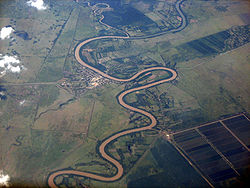
Def. a winding, crooked, or involved course or a tortuous or intricate movement of water as a stream or river is called a meander.
Rapids
[edit | edit source]
Def. a rough section of a river or stream which is difficult to navigate due to the swift and turbulent motion of the water is called a rapid.
On the right are rapids featuring white water before the Rhine Falls.
Waterfalls
[edit | edit source]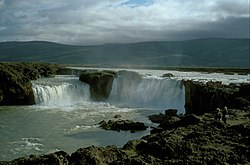

Def. a flow of water over the edge of a cliff is called a waterfall.
Angel Falls in the image on the left is the world's tallest at 979 m.
Meltwaters
[edit | edit source]"On a summit flight, we were able to see the source of the meltwater stream. It appears to starts to the right of the dome where a fall face can be seen and continues down."[48]
The image on the left shows flooding some 7.6 m deep caused by the melting of Drift Glacier.
Lavas
[edit | edit source]

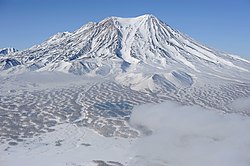
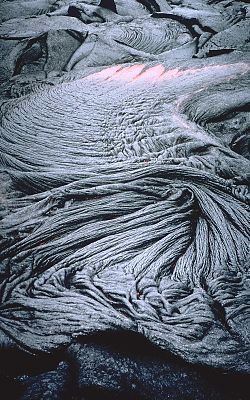
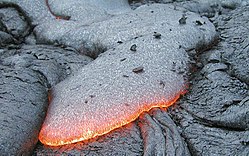

Def. melted rock ejected by a volcano from its crater or fissured sides is called a lava.
Usage notes
Geologists make a distinction between magma (molten rock underground) and lava (molten rock on the surface).
Def. molten matter within the earth, the source of the material of lava flows, dikes of eruptive rocks, etc is called a magma.
"Streams of molten rock that ooze from gaps or vents in the Earth’s surface are called lava flows. Though generally slow-moving, these rivers of rock pose a hazard to everything in their paths. They can bury or burn homes and roads, ruin farmland for generations, and transform glaciers into muddy landslides (lahars)."[49]
"Lava flows can take many shapes and move at very different rates depending on the viscosity of the magma, the slope of the land, and the rate of an eruption. Some of the speediest flows travel 60 kilometers (40 miles) per hour; the slowest creep along at less than 1 kilometer (0.6 miles) per hour. They can sometimes even flow for more than a year after an eruption has ended."[49]
"While viscous lava flows are defined by steep flow fronts and pressure ridges, low-viscosity lavas tend to move faster and create longer, narrower shapes. They also tend to have smaller flow fronts and levee-like structure along their edges. Many characteristics of a low-viscosity lava flow are visible in [the image on the right second down] of Zhupanovsky and Dzenzursky volcanoes on Russia’s Kamchatka Peninsula. The image was acquired by the Operational Land Imager (OLI) on the Landsat 8 satellite on September 9, 2013."[50]
"In the image, younger lava flows appear grey, while older flows are covered by green vegetation. The exact ages of the flows are unclear, but the eruptions that produced them likely occurred during the past few thousand years. Distinctive lava levees are visible along the edges of many of the younger flows. These features form as lava cools and hardens along the edges or top of a flow while the center of a flow still advances."[50]
"In comparison to the Chao dacite in Chile (the product of viscous lava), the flows at Zhupanovsky [at lowest right] and Dzenzursky are much narrower and longer. They have smaller flow fronts (10 to 30 meters tall) in comparison to the sheer 400-meter cliffs at Chao, as well as more prominent lava levees along the edges. Like Chao, the flows shown above have pressure ridges caused by the compression of the cooling top of the lava as the flow advanced."[50]
Def. a form of lava flow of basaltic rock, usually dark-colored with a smooth or ropey surface is called pahoehoe.
"Ropy pahoehoe [shown in the fourth image down on the right, taken 11 June 1995] is the most common surface texture of pahoehoe flows. The numerous folds and wrinkles ("ropes") that are characteristic of ropy pahoehoe form when the thin, partially solidified crust of a flow is slowed or halted (for example, if the crust encounters an obstruction or slower-moving crust). Because lava beneath the crust continues to move forward, it tends to drag the crust along. The crust then behaves like an accordian that is squeezed together--the crust is flexible enough to develop wrinkles or a series of small ridges and troughs as it is compressed and driven forward."[51]
Def. a form of lava flow [shown on the right, fifth image down] consisting of basaltic rock, usually dark-colored with a jagged and loose, clinkery surface is called an aa.
"`A`a (pronounced "ah-ah") is a Hawaiian term for lava flows that have a rough rubbly surface composed of broken lava blocks called clinkers. The incredibly spiny surface of a solidified `a`a flow makes walking very difficult and slow. The clinkery surface actually covers a massive dense core, which is the most active part of the flow. As pasty lava in the core travels downslope, the clinkers are carried along at the surface. At the leading edge of an `a`a flow, however, these cooled fragments tumble down the steep front and are buried by the advancing flow. This produces a layer of lava fragments both at the bottom and top of an `a`a flow."[52]
Rocky meteors
[edit | edit source]"A skydiver may have captured the first film ever of a meteorite plunging down at terminal velocity, also known as its “dark flight” stage."[53]
"The footage was captured in 2012 by a helmet cam worn by Anders Helstrup as he and other members of the Oslo Parachute Club jumped from a small plane that took off from an airport in Hedmark, Norway."[53]
“It can’t be anything else. The shape is typical of meteorites -- a fresh fracture surface on one side, while the other side is rounded.”[54]
“It has never happened before that a meteorite has been filmed during dark flight; this is the first time in world history.”[54]
"Having the rock in hand would certainly help. But despite triangulations and analyses, Helstrup and his recruits still haven’t found it."[53]
Meteoroids
[edit | edit source]Def. "a relatively small (sand- to boulder-sized) fragment of debris in a solar system"[55] is called a meteoroid.
"As of 2011 the International Astronomical Union officially defines a meteoroid as a solid object moving in interplanetary space, of a size considerably smaller than an asteroid and considerably larger than an atom".[56][57]
The visible path of a meteoroid that enters the Earth's atmosphere (or another body's) atmosphere is called a meteor, or colloquially a shooting star or falling star. If a meteoroid reaches the ground and survives impact, then it is called a meteorite.
Beech and Steel, writing in Quarterly Journal of the Royal Astronomical Society, proposed a new definition where a meteoroid is between 100 µm and 10 m across.[58] Following the discovery and naming of asteroids below 10 m in size (e.g., 2008 TC3), Rubin and Grossman refined the Beech and Steel definition of meteoroid to objects between 10 µm and 1 m in diameter.[59] The [near-Earth object] NEO definition includes larger objects, up to 50 m in diameter, in this category. Very small meteoroids are known as micrometeoroids (see also interplanetary dust).
The composition of meteoroids can be determined as they pass through Earth's atmosphere from their trajectories and the light spectra of the resulting meteor. Their effects on radio signals also give information, especially useful for daytime meteors which are otherwise very difficult to observe.
The light spectra, combined with trajectory and light curve measurements, have yielded various compositions and densities, ranging from fragile snowball-like objects with density about a quarter that of ice,[60] to nickel-iron rich dense rocks.
In meteoroid ablation spheres from deep-sea sediments, "[t]he silicate spheres are the most dominant group."[61]
From these trajectory measurements, meteoroids have been found to have many different orbits, some clustering in streams (see Meteor showers) often associated with a parent comet, others apparently sporadic. Debris from meteoroid streams may eventually be scattered into other orbits. ... Meteoroids travel around the Sun in a variety of orbits and at various velocities. The fastest ones move at about 26 miles per second (42 kilometers per second) through space in the vicinity of Earth's orbit. The Earth travels at about 18 miles per second (29 kilometers per second). Thus, when meteoroids meet the Earth's atmosphere head-on (which would only occur if the meteors were in a retrograde orbit), the combined speed may reach about 44 miles per second (71 kilometers per second). Meteoroids moving through the earth's orbital space average about 20 km/s.[62]
Fireballs
[edit | edit source]Above is a visual astronomy image of a fireball trail with some burning still visible from a meteor as it passed overhead in Chelyabinsk, Russia, on February 15, 2013.
A relatively small percentage of meteoroids hit the Earth's atmosphere and then pass out again: these are termed Earth-grazing fireballs (for example The Great Daylight 1972 Fireball).
For 2011 there are 4589 fireball records at the American Meteor Society.[63]
"At 66 kilometers (41 miles) per second, they appear as fast streaks, faster by a hair than their sisters, the Eta Aquarids of May. And like the Eta Aquarids, the brightest of family tend to leave long-lasting trains. Fireballs are possible three days after maximum."[64]
Bolides
[edit | edit source]Def. a fireball reaching magnitude −14 or brighter.[65] is called a bolide.
Def. a fireball reaching an magnitude −17 or brighter is called a superbolide.
Meteor showers
[edit | edit source]
Meteors may occur in showers, which arise when the Earth passes through a trail of debris left by a comet, or as "random" or "sporadic" meteors, not associated with a specific single cause. A number of specific meteors have been observed, largely by members of the public and largely by accident.
Cryometeors
[edit | edit source]
A megacryometeor is a very large chunk of ice sometimes called huge hailstones, but do not need to form in thunderstorms.
Glaciers
[edit | edit source]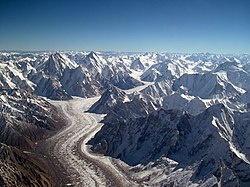
A glacier is a slowly moving river of ice. As with rivers of water, a glacier usually follows its stream bed from a high altitude source to sea level.
Glacial fracturing
[edit | edit source]"Icequakes are seismic tremblings caused by sudden movement within a glacier or ice sheet, such as from a fracturing crevasse. (Anyone who has dropped an ice cube into a glass of water knows ice snaps under stress.)"[66]
"Chile's magnitude-8.8 earthquake on Feb. 27, 2010, set off a flurry of Antarctic icequakes, each lasting from one to 10 seconds, researchers report today (Aug. 10) in the journal Nature Geoscience. The epicenter was 2,900 miles (4,700 km) north of Antarctica."[66]
"We think the crevasses are being activated by the surface waves from this big earthquake coming through, and that's making the icequake."[67]
"An iceberg [in the image on the right] expected to be one of the 10 largest ever recorded is ready to break away from Antarctica."[68]
"A long-running rift in the Larsen C ice shelf grew suddenly in December and now just 20 km of ice is keeping the 5,000 sq km piece from floating away."[69]
"Larsen C is about 350m thick and floats on the seas at the edge of West Antarctica, holding back the flow of glaciers that feed into it."[69]
"Researchers have been tracking the rift in Larsen C for many years, watching it with some trepidation after the collapse of Larsen A ice shelf in 1995 and the sudden break-up of the Larsen B shelf in 2002."[69]
In "December [2016] the speed of the rift went into overdrive, growing by a further 18 km in just a couple of weeks."[69]
"The rift is about 100 m wide but is estimated to be half a kilometre deep."[69]
This "is a geographical and not a climate event. The rift has been present for decades, but it has punched through at this particular time."[68]
"The collapse of the Larsen B ice shelf which occurred in 2002 followed on from a large rift calving event."[69]
"We would expect in the ensuing months to years further calving events [from Larsen C], and maybe an eventual collapse - but it's a very hard thing to predict, and our models say it will be less stable; not that it will immediately collapse or anything like that."[68]
"Even the sea level contribution of this area is not on anybody's radar; it's just a big geographical event that will change the landscape there."[68]
Glacial surges
[edit | edit source]Def. "a glacier that experiences a dramatic increase in flow rate, 10 to 100 times faster than its normal rate; usually surge events last less than one year and occur periodically, between 15 and 100 years"[70] is called a surging glacier.
"In 1941, Hole-in-the-Wall Glacier [imaged at the right] surged, also knocking over trees during its advance."[70]
An "outlet glacier of the Sermersauq Ice Cap [on Disko Island, West Greenland, shown at the left with progressive surges marked] has surged 10.5 km downvalley to within 10 km of the fjord. [...] surging of the glacier, begun in 1995, was undetected until July 1999, when it was discovered during a geomorphic survey of the valley. Mapping from TM, Landsat and SPOT satellite imagery, and subsequent field work have documented the history of the event. On 17 June 1995 the terminus of the glacier was about where it appears in the 1985 air photography [...]. By 24 September 1995 the glacier had advanced 1.25 km and by 12 October another 1.25 km (mean advance during the second period : 70 m day-1). The advance slowed from 18 m day-1 in 1996 to 5 m day-1 in 1997 and <1 m day-1 between 1997 and 1999. By summer 1999 the advance ceased; the maximum extension of the terminus, about 10.5 km down-valley to about 10 km from the head of the fjord, was mapped from imagery on 9 July 1999 [...]."[71]
Glacial calving
[edit | edit source]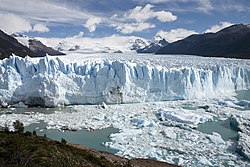

The image on the right shows calving by the Perito Moreno Glacier, in Los Glaciares National Park, southern Argentina.
"Calving of huge, tabular icebergs is unique to Antarctica, and the process can take a decade or longer. Calving results from rifts that reach across the shelf. In the case of Antarctica's Amery Ice Shelf, the calving area resembles a loose tooth [images on the second right]."[72]
"On a stable ice shelf, calving is a near-cyclical, repetitive process producing large icebergs every few decades. The icebergs drift generally westward around the continent, and as long as they remain in the cold, near-coastline water, they can survive decades or more. However, they eventually are caught up in north-drifting currents where they melt and break apart."[72]
"In Greenland, floating ice tongues downstream from large outlet glaciers are more broken up by crevasses. Calving of the ice tongues releases armadas of smaller, steep-sided icebergs that drift south sometimes reaching North Atlantic shipping lanes. Calving of the large glacier, Jacobshavn, on the east coast of Greenland is responsible for the majority of icebergs reaching Atlantic shipping and fishing areas off of Newfoundland and most likely shed the iceberg responsible for the sinking of the Titanic in 1912. The Petermann Glacier in northwestern Greenland also shed a large ice island in August 2010. These denizens of the ocean are now tracked by the National Ice Center in the United States, along with other organizations."[72]
"By 2006, the Jacobshavn Glacier [third image on the right] had retreated back to where its two main tributaries join, leading to two fast-flowing glaciers where there had previously been just one."[72]
"The rapidly retreating Jakobshavn Glacier in western Greenland drains the central ice sheet. This image [third one on the right] shows the glacier in 2001, flowing from upper right to lower left. Terminus locations before 2001 were determined by surveys and more recent contours were derived from Landsat data. The recent stages of retreat have widened the ice front, placing more of the glacier in contact with the ocean."[72]
"In recent years, calving of the largest ice tongues in Greenland (in particular, Jacobshavn, Helheim, and Kangerdlugssuaq) has accelerated probably due to warmer air and/or ocean temperatures. As the ice tongues have retreated, the reduced backpressure against the glacier has allowed these glaciers to accelerate significantly."[72]
"The images [fourth set of images on the right] show a tabular iceberg calving from an ice shelf. This iceberg happens to be calving from the remnant piece of the Larsen B ice shelf at the southwestern corner of the embayment. While the Larsen B Ice Shelf underwent disintegration [...], this was a normal calving event."[72]
"Large tabular iceberg calvings are natural events that occur under stable climatic conditions, so they are not a good indicator of warming or changing climate. Over the past several decades, however, meteorological records have revealed atmospheric warming on the Antarctic Peninsula, and the northernmost ice shelves on the peninsula have retreated dramatically (Vaughan and Doake 1996)."[72]
"The most pronounced ice shelf retreat has occurred on the Larsen Ice Shelf, located on the eastern side of the Antarctic Peninsula's northern tip. The shelf is divided into four regions from north to south: A, B, C, and D."[72]
Lithometeors
[edit | edit source]
Def. a suspension of dry dust in the atmosphere is called a lithometeor.
Def. the solid material thrown into the air by a volcanic eruption that settles on the surrounding areas is called tephra.
Micrometeors
[edit | edit source]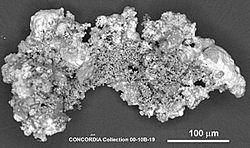
A micrometeoroid is a tiny meteoroid; a small particle of rock in space, usually weighing less than a gram. A micrometeorite is such a particle that survives passage through the Earth's atmosphere and reaches the Earth's surface.
Micrometeoroids are extremely common in space. These tiny particles are a major contributor to space weathering processes. When they hit the surface of the Moon, or any airless body (Mercury, the asteroids, etc.), the resulting melting and vaporization causes darkening and other optical changes in the regolith.
Micrometeoroids have less stable orbits than meteoroids, due to their greater surface area to mass ratio.
Micrometeoroids pose a significant threat to space exploration.[73] Their velocities relative to a spacecraft in orbit average 10 kilometers per second (22,500 mph),[73] and resistance to micrometeoroid impact is a significant design challenge for spacecraft and space suit designers (See Thermal Micrometeoroid Garment). While the tiny sizes of most micrometeoroids limits the damage incurred, the high velocity impacts will constantly degrade the outer casing of spacecraft in a manner analogous to sandblasting. Long term exposure can threaten the functionality of spacecraft systems.
Hydrometeors
[edit | edit source]Def. precipitation products of the condensation of atmospheric water vapour are called hydrometeors.
Def. any or all of the forms of water particles, whether liquid or solid, that fall from the atmosphere are called precipitation.
Emissions
[edit | edit source]Def. the solid material thrown into the air by a volcanic eruption that settles on the surrounding areas is called tephra.
"[T]ephra, is a general term for fragments of volcanic rock and lava that are blasted into the air by volcanic explosions or carried upward in the volcanic plume by hot, hazardous gases. The larger fragments usually fall close to the volcano, but the finer particles can be advected quite some distance. ... [Fine ash] can contain rock, minerals, and volcanic glass fragments smaller than .1 inch in diameter, or slightly larger than the size of a pinhead."[46]
Absorptions
[edit | edit source]"[T]he carbonaceous material [is] known from observation to dominate the terrestrial [micrometeorite (MM)] flux."[74]
"Ureilites occur about half as often as eucrites (Krot et al. 2003), are relatively friable, have less a wide range of cosmic-ray exposure ages including two less than 1 Myr, and, like the dominant group of MM precursors, contain carbon."[74]
Comets
[edit | edit source]

Jupiter has been called the Solar System's vacuum cleaner,[76] because of its immense gravity well and location near the inner Solar System. It receives the most frequent comet impacts of the Solar System's planets.[77]
A 1997 survey of historical astronomical drawings suggested that the astronomer [Giovanni Domenico Cassini] Cassini may have recorded an impact scar in 1690. The survey determined eight other candidate observations had low or no possibilities of an impact.[78] A fireball was photographed by Voyager 1 during its Jupiter encounter in March 1979.[79] During the period July 16, 1994, to July 22, 1994, over 20 fragments from the comet Shoemaker–Levy 9 (SL9, formally designated D/1993 F2) collided with Jupiter's southern hemisphere, providing the first direct observation of a collision between two Solar System objects. This impact provided useful data on the composition of Jupiter's atmosphere.[80][81]
On July 19, 2009, an impact site was discovered at approximately 216 degrees longitude in System 2.[82][83] This impact left behind a black spot in Jupiter's atmosphere, similar in size to Oval BA. Infrared observation showed a bright spot where the impact took place, meaning the impact warmed up the lower atmosphere in the area near Jupiter's south pole.[84]
2010 Jupiter impact event: A fireball, smaller than the previous observed impacts, was detected on June 3, 2010, by Anthony Wesley, an amateur astronomer in Australia, and was later discovered to have been captured on video by another amateur astronomer in the Philippines.[85] Yet another fireball was seen on August 20, 2010.[86]
On September 10, 2012, another fireball was detected.[79][87]
The second image at right shows the atmospheric impact sites for the Comet Shoemaker-Levy 9 fragments. Spectroscopic studies revealed absorption lines in the Jovian spectrum due to diatomic sulfur (S2) and carbon disulfide (CS2), the first detection of either in Jupiter, and only the second detection of S2 in any astronomical object. Other molecules detected included ammonia (NH3) and hydrogen sulfide (H2S). The amount of sulfur implied by the quantities of these compounds was much greater than the amount that would be expected in a small cometary nucleus, showing that material from within Jupiter was being revealed.
"Sun-grazing comets almost never re-emerge, but their sublimative destruction near the sun has only recently been observed directly, while chromospheric impacts have not yet been seen, nor impact theory developed."[88] "[N]uclei are ... destroyed by ablation or explosion ... in the chromosphere, producing flare-like events with cometary abundance spectra."[88]
"The death of a comet at r ~ Rʘ has been seen directly only very recently (Schrijver et al 2011) using the SDO AIA XUV instrument. This recorded sublimative destruction of Comet C/2011 N3 as it crossed the solar disk very near periheloin q = 1.139Rʘ."[88]
"The phenomenon of flare induced sunquakes - waves in the photosphere - discovered by Kosovichev and Zharkova (1998) and now widely studied (e.g. Kosovichev 2006) should also result from the momentum impulse delivered by a cometary impact."[88]
Rogue planets
[edit | edit source]A rogue planet — also known as an interstellar planet, nomad planet, free-floating planet or orphan planet — is a planetary-mass object which has either been ejected from its system or was never gravitationally bound to any star, brown dwarf or other such object, and that therefore orbits the galaxy directly.[89][90][91] Astronomers agree that either way, the definition of planet should depend on its current observable state and not its origin.
Larger planetary-mass objects which were not ejected, but have always been free-floating, are thought to have formed in a similar way to stars, and the IAU has proposed that those objects be called sub-brown dwarfs[92] (an example of this is Cha 110913-773444, which may be an ejected rogue planet or may have formed on its own and be a sub-brown dwarf).[93] The closest rogue planet to Earth yet discovered, CFBDSIR 2149-0403, is around 100 light years away.[94]
When a planetary-sized object passes in front of a background star, its gravitational field causes a momentary increase in the visible brightness of the background star. This is known as microlensing. Astrophysicist Takahiro Sumi of Osaka University in Japan and colleagues, who form the Microlensing Observations in Astrophysics (MOA) and the Optical Gravitational Lensing Experiment (OGLE) collaborations, carried out a study of microlensing which they published in 2011. They observed 50 million stars in our galaxy using the 1.8 meter MOA-II telescope at New Zealand's Mount John Observatory and the 1.3 meter University of Warsaw telescope at Chile's Las Campanas Observatory. They found 474 incidents of microlensing, ten of which were brief enough to be planets of around Jupiter's size with no associated star in the immediate vicinity. The researchers estimated from their observations that there are nearly two free-floaters for every star in our galaxy.[95][96][97] Other estimations suggest a much larger number, up to 100,000 times more free-floating planets than stars in our Milky Way.[98]
Asteroids
[edit | edit source]Asteroids are small rocky objects orbiting the Sun.
Large numbers of asteroids as indicated in the image from Gaia at the top ranging in size from Ceres to dust particles are found in the asteroid belt especially between the orbits of Mars and Jupiter.
Centaurs
[edit | edit source]Def. an "icy planetoid that orbits the Sun between Jupiter and Neptune"[99] is called a Centaur.
"The recent investigation of the orbital distribution of Centaurs (Emel’yanenko et al., 2005) showed that there are two dynamically distinct classes of Centaurs, a dominant group with semimajor axes a > 60 AU and a minority group with a < 60 AU."[100] "[T]he intrinsic number of such objects is roughly an order of magnitude greater than that for a<60 AU".[100]
Moons
[edit | edit source]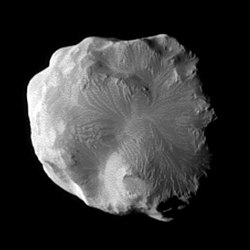

"Cassini imaged [on the right] the surface of Saturn's moon Helene as the spacecraft flew by the moon on Jan. 31, 2011."[101]
"This small moon leads Dione by 60 degrees in the moons' shared orbit. Helene is a "Trojan" moon of Dione, named for the Trojan asteroids that orbit 60 degrees ahead of and behind Jupiter as it circles the Sun."[101]
"This view looks toward the leading hemisphere of Helene (33 kilometers, 21 miles across). North on Helene is up and rotated 2 degrees to the left."[101]
"The image was taken with the Cassini spacecraft narrow-angle camera using a combination of spectral filters sensitive to wavelengths of polarized green light centered at 617 and 568 nanometers. The view was obtained at a distance of approximately 31,000 kilometers (19,000 miles) from Helene and at a Sun-Helene-spacecraft, or phase, angle of 65 degrees. Scale in the original image was 187 meters (612 feet) per pixel. The image was contrast enhanced and magnified by a factor of 1.5 to enhance the visibility of surface features."[101]
"NASA's Cassini spacecraft captured this view [on the left] of Saturn's moon Epimetheus (116 kilometers, or 72 miles across) during a moderately close flyby on Dec. 6, 2015. This is one of Cassini's highest resolution views of the small moon, along with PIA09813."[102]
"This view looks toward the Saturn facing side of Epimetheus. North on Epimetheus is up. The image was taken in green polarized light with the Cassini spacecraft narrow-angle camera."[102]
Superluminals
[edit | edit source]
"In far-distant quasars and galaxies, millions or even billions of light-years away, the gravitational energy of supermassive black holes is capable of accelerating "jets" of subatomic particles to speeds approaching that of light. The VLA has observed such jets for many years. In some of these jets, blobs of material have been seen to move at apparent speeds greater than that of light -- a phenomenon called superluminal motion. The apparent faster-than-light motion actually is an illusion seen when a jet of material is travelling close to -- but below -- the speed of light and directed toward Earth."[103]
"In the Spring of 1994, Felix Mirabel from Saclay, France, and Luis Rodriguez, from the National Autonomous University in Mexico City, were observing an X-ray emitting object called GRS 1915+105, which had just shown an outburst of radio emission. This object was known to be about 40,000 light-years away, within our own Milky Way Galaxy -- in our own cosmic neighborhood. Their time series of VLA observations, seen in this image, showed that a pair of objects ejected from GRS 1915+105 were moving apart at an apparently superluminal speed. This was the first time that superluminal motion had been detected in our own Galaxy."[103]
"This surprising result showed that the supermassive black holes at the centers of galaxies -- black holes millions of times more massive than the Sun -- have smaller counterparts capable of producing similar jet ejections. GRS 1915+105 is thought to be a double-star system in which one of the components is a black hole or neutron star only a few times the mass of the Sun. The more-massive object is pulling material from its stellar companion. The material circles the massive object in an accretion disk before being pulled into it. Friction in the accretion disk creates temperatures hot enough that the material emits X-rays, and magnetic processes are believed to accelerate the material in the jets."[103]
"Since Mirabel and Rodriguez discovered the superluminal motion in GRS 1915+105, several other Galactic "microquasars" have been discovered and studied with the VLA and the VLBA. In 1999, NRAO astronomer Robert Hjellming turned the VLA toward a bursting microquasar within 24 hours of a reported X-ray outburst. Working with X-ray observers Donald Smith and Ronald Remillard of MIT, Hellming found that this object is a microquasar only 1,600 light-years away, making it the closest black hole to Earth yet discovered."[103]
"Microquasars within our own Galaxy, because they are closer and thus easier to study, have become invaluable "laboratories" for revealing the physical processes that produce superfast jets of material. For discovering this new class of celestial object, Mirabel and Rodriguez received the prestigous Bruno Rossi Prize of the American Astronomical Society in 1997."[103]
"On the far side of our Galaxy, gas clouds explode away from a small black hole. This might seem peculiar, as black holes are supposed to attract matter. But material falling toward a black hole collides and heats up, creating an environment similar to a quasar that is far from stable. In the [at second right] time-lapse sequence, micro-quasar GRS1915 expels bubbles of hot gas in spectacular jets. These computer enhanced radio images show one plasma bubble coming almost directly toward us at 90 percent the speed of light, and another moving away. Each of the four frames marks the passage of one day. Originally detected on October 29th, these bubbles have now faded from view."[103]
See also
[edit | edit source]References
[edit | edit source]- ↑ 1.0 1.1 1.2 1.3 1.4 1.5 B. Saxton; F. Lockman; A. Mellinger; Ann Jenkins; Ray Villard (28 January 2016). Hubble Sees Monstrous Cloud Boomerang Back to our Galaxy. Washington, DC USA: NASA. http://www.nasa.gov/feature/goddard/2016/hubble-sees-monstrous-cloud-boomerang-back-to-our-galaxy. Retrieved 2016-11-05.
- ↑ Marshallsumter (September 24, 2011). meteor. San Francisco, California USA: Wikimedia Foundation, Inc. http://en.wikiversity.org/wiki/Radiation/Meteors. Retrieved 2018-01-24.
- ↑ 3.0 3.1 M. Gregg (3 March 2005). The Impending Destruction of NGC 1427A. Baltimore, Maryland USA: Hubblesite.org. http://hubblesite.org/newscenter/archive/releases/2005/09/image/a/. Retrieved 2016-11-05.
- ↑ Juna A. Kollmeier; Andrew Gould (July 20, 2007). "Where Are the Old-Population Hypervelocity Stars?". The Astrophysical Journal 664 (1): 343-8. doi:10.1086/518405. http://iopscience.iop.org/0004-637X/664/1/343. Retrieved 2012-03-05.
- ↑ Martin A. Barstow; L. Binette; Noah Brosch; F.Z. Cheng; Michel Dennefeld; A.I. G. de Castro; H. Haubold; K.A. van der Hucht et al. (February 26, 2003). J. Chris Blades. ed. The WSO: a world-class observatory for the ultraviolet, In: Future EUV/UV and Visible Space Astrophysics Missions and Instrumentation. 4854. The International Society for Optical Engineering. doi:10.1117/12.459779. http://proceedings.spiedigitallibrary.org/proceeding.aspx?articleid=876587. Retrieved 2013-07-15.
- ↑ Martin, Christopher; Seibert, M; Neill, JD; Schiminovich, D; Forster, K; Rich, RM; Welsh, BY; Madore, BF et al. (August 17, 2007). "A turbulent wake as a tracer of 30,000 years of Mira's mass loss history". Nature 448 (7155): 780–783. doi:10.1038/nature06003. PMID 17700694.
- ↑ Minkel, JR."Shooting Bullet Star Leaves Vast Ultraviolet Wake", "The Scientific American", August 15, 2007 Accessed August 21, 2007.
- ↑ Wareing, Christopher; Zijlstra, A. A.; O'Brien, T. J.; Seibert, M. (November 6, 2007). "It's a wonderful tail: the mass-loss history of Mira". Astrophysical Journal Letters 670 (2): L125–L129. doi:10.1086/524407. http://www.iop.org/EJ/article/1538-4357/670/2/L125/22252.html.
- ↑ W. Clavin (August 15, 2007). GALEX finds link between big and small stellar blasts. California Institute of Technology. Archived from the original on 2007-08-27. http://web.archive.org/web/20070827103038/http://www.galex.caltech.edu/MEDIA/2007-04/images.html. Retrieved 2007-08-16.
- ↑ Christopher Wareing (December 13, 2008). "Wonderful Mira". Philosophical Transactions of the Royal Society A 366 (1884): 4429–40. doi:10.1098/rsta.2008.0167. PMID 18812301.
- ↑ M. Karovska (April 28, 2005). More Images of Mira. NASA/CXC/SAO/M. Karovska, et al.. http://chandra.harvard.edu/photo/2005/mira/more.html. Retrieved 2012-12-22.
- ↑ Castelaz, Michael W.; Luttermoser, Donald G. (1997). "Spectroscopy of Mira Variables at Different Phases.". The Astronomical Journal 114: 1584–1591. doi:10.1086/118589.
- ↑ Woodruff, H. C.; Eberhardt, M.; Driebe, T.; Hofmann, K.-H.; Ohnaka, K.; Richichi, A.; Schert, D.; Schöller, M. et al. (2004). "Interferometric observations of the Mira star o Ceti with the VLTI/VINCI instrument in the near-infrared" (PDF). Astronomy & Astrophysics 421 (2): 703–714. doi:10.1051/0004-6361:20035826. http://www.eso.org/~mwittkow/publications/conferences/SPIECWo5491199.pdf. Retrieved 2007-12-07.
- ↑ Ray Villard; Tod Lauer; Sandra Faber (20 July 1993). Hubble Space Telescope Finds a Double Nucleus in the Andromeda Galaxy. http://hubblesite.org/newscenter/archive/releases/1993/18/text/. Retrieved 2016-11-05.
- ↑ 15.0 15.1 Roger Lynds; Earl J. O'Neil Jr. (March 1996). A Bird's eye view of a Galaxy Collision. Greenbelt, Maryland USA: NASA Goddard Space Flight Center. https://commons.wikimedia.org/wiki/File:NGC_6745.jpg. Retrieved 2016-11-05.
- ↑ 16.0 16.1 16.2 16.3 16.4 Sebastian Heinz (23 June 2015). Circinus X-1. http://chandra.si.edu/photo/2015/cirx1/. Retrieved 2016-11-05.
- ↑ Miller (1998). Description. University of Alaska. http://www.avo.alaska.edu/volcanoes/volcinfo.php?volcname=Redoubt. Retrieved 2016-02-18.
- ↑ R. G. Harrison; K. S. Carslaw (September 2003). "Ion-aerosol-cloud processes in the lower atmosphere". Reviews of Geophysics 41 (3): 1012. doi:10.1029/2002RG000114. http://onlinelibrary.wiley.com/doi/10.1029/2002RG000114/full. Retrieved 2015-01-06.
- ↑ Eileen K. Stansbery (March 1989). A global model of thunderstorm electricity and the prediction of whistler duct formation. Houston, Texas USA: Rice University. pp. 174. http://scholarship.rice.edu/bitstream/handle/1911/16298/9012871.PDF?sequence=1. Retrieved 2015-01-03.
- ↑ C. G. Park; M. Dejnakarintra (1 October 1973). "Penetration of thundercloud electric fields into the ionosphere and magnetosphere: 1. Middle and subauroral latitudes". Journal of Geophysical Research Space Physics 78 (28): 6623-33. doi:10.1029/JA078i028p06623. http://onlinelibrary.wiley.com/doi/10.1029/JA078i028p06623/abstract. Retrieved 2015-01-06.
- ↑ M.S. Muir; C.A. Smart (February 1981). "Diurnal variations in the atmospheric electric field on the South Polar ice-cap". Journal of Atmospheric and Terrestrial Physics 43 (2): 171-7. doi:10.1016/0021-9169(81)90077-5. http://www.sciencedirect.com/science/article/pii/0021916981900775. Retrieved 2015-01-06.
- ↑ Robert Nemiroff (MTU); Jerry Bonnell (USRA) (June 30, 2003). Disappearing Clouds in Carina. Goddard Space Flight Center, Greenbelt, Maryland, USA: NASA. http://apod.nasa.gov/apod/ap030630.html. Retrieved 2012-09-05.
- ↑ Craig Kulesa. Overview: Molecular Astrophysics and Star Formation. http://loke.as.arizona.edu/~ckulesa/research/overview.html. Retrieved September 7, 2005.
- ↑ 24.0 24.1 See, e.g., Table 1 and the Appendix of Murray, N. (2011). "Star Formation Efficiencies and Lifetimes of Giant Molecular Clouds in the Milky Way". The Astrophysical Journal 729 (2): 133. doi:10.1088/0004-637X/729/2/133.
- ↑ J. P. Williams; L. Blitz; C. F. McKee (2000). The Structure and Evolution of Molecular Clouds: from Clumps to Cores to the IMF, In: Protostars and Planets IV. Tucson: University of Arizona Press. pp. 97. https://arxiv.org/pdf/astro-ph/9902246.
- ↑ Di Francesco, J. (2006). An Observational Perspective of Low-Mass Dense Cores I: Internal Physical and Chemical Properties, In: Protostars and Planets V. https://arxiv.org/pdf/astro-ph/0602379.
- ↑ Grenier (2004). The Gould Belt, star formation, and the local interstellar medium, In: The Young Universe. http://uk.arxiv.org/abs/astro-ph/0409096.
- ↑ Sagittarius B2 and its Line of Sight
- ↑ 29.0 29.1 29.2 Feigelson ED, Lawson WA (October 2004). "An X-ray census of young stars in the Chamaeleon I North Cloud". The Astrophysical Journal 614 (10): 267–83. doi:10.1086/423613. http://www.iop.org/EJ/article/0004-637X/614/1/267/60370.web.pdf?request-id=63d27661-73a2-47f1-8b87-17c4df8c7e65.
- ↑ 30.0 30.1 30.2 Alcalá JM; Covino E; Sterzik MF; Schmitt JHMM; Krautter J; Neuhäuser R (March 2000). "A ROSAT pointed observation of the Chamaeleon II dark cloud". Astronomy & Astrophysics 355 (3): 629–38.
- ↑ Yamauchi S; Hamaguchi K; Koyama K; Murakami H (October 1998). "ASCA Observations of the Chamaeleon II Dark Cloud". Publ Astron Soc Japan 50 (10): 465–74.
- ↑ Hamaguchi K; Yamauchi S; Koyama K. "X-ray Study of the Intermediate-Mass Young Stars Herbig Ae/Be Stars". The Astrophysical Journal 2005 618: 260. doi:10.1086/423192.
- ↑ Burlaga L. F.; E. Sittler; F. Mariani; R. Schwenn. "Magnetic loop behind an interplanetary shock: Voyager, Helios and IMP-8 observations". Journal of Geophysical Research 86: 6673 1981. http://onlinelibrary.wiley.com/doi/10.1029/JA086iA08p06673/pdf.
- ↑ Burlaga, L. F.. "A magnetic cloud and a coronal mass ejection". Geophysical Research Letters 9: 1317-1320 1982. http://onlinelibrary.wiley.com/doi/10.1029/GL009i012p01317/full.
- ↑ Lepping, R. P.. "Magnetic field structure of interplanetary magnetic clouds at 1 AU". Journal of Geophysical Research 95: 11957-11965 1990.
- ↑ R. P. Lin; H. S. Hudson (September-October 1976). "Non-thermal processes in large solar flares". Solar Physics 50 (10): 153-78. doi:10.1007/BF00206199. http://adsabs.harvard.edu/full/1976SoPh...50..153L. Retrieved 2013-07-07.
- ↑ E. Tandberg-Hanssen (1977). A. Bruzek. ed. Prominences, In: Illustrated Glossary for Solar and Solar-Terrestrial Physics. Dordrecht-Holland: D. Reidel Publishing Company. pp. 97-109. doi:10.1007/978-94-010-1245-4_10. ISBN 978-94-010-1247-8. http://link.springer.com/chapter/10.1007/978-94-010-1245-4_10. Retrieved 2013-07-10.
- ↑ 38.0 38.1 Lisa Winter (May 12, 2014). Origins Of Mysterious "Sprite" Lightning Discovered. IFLScience. http://www.iflscience.com/environment/origins-mysterious-sprite-lightning-discovered. Retrieved 2014-08-30.
- ↑ Jianqi Qin (May 12, 2014). Origins Of Mysterious "Sprite" Lightning Discovered. IFLScience. http://www.iflscience.com/environment/origins-mysterious-sprite-lightning-discovered. Retrieved 2014-08-30.
- ↑ 40.0 40.1 40.2 40.3 40.4 40.5 Stephen Luntz (May 16, 2014). Solar Activity Could Cause Lightning Storms On Earth. http://www.iflscience.com/space/solar-activity-could-cause-lightning-storms-earth. Retrieved 2014-08-31.
- ↑ 41.0 41.1 41.2 Christ Scott (May 16, 2014). Solar Activity Could Cause Lightning Storms On Earth. http://www.iflscience.com/space/solar-activity-could-cause-lightning-storms-earth. Retrieved 2014-08-31.
- ↑ 42.0 42.1 42.2 Katie Pennicott (25 June 2003). Giant jets caught on camera. Institute of Physics. http://physicsworld.com/cws/article/news/2003/jun/25/giant-jets-caught-on-camera. Retrieved 2015-04-11.
- ↑ NASA (31 August 2012). Plasma Burst. Greenbelt, Maryland USA: NASA. https://www.pinterest.com/pin/105764291220958091/. Retrieved 2015-05-18.
- ↑ S.R. Federman, David L. Lambert (May 2002). "The need for accurate oscillator strengths and cross sections in studies of diffuse interstellar clouds and cometary atmospheres". Journal of Electron Spectroscopy and Related Phenomena 123 (2-3): 161-71. http://www.sciencedirect.com/science/article/pii/S0368204802000178. Retrieved 2013-01-20.
- ↑ 45.0 45.1 Bill Keel (October 2003). The interaction of jets and clouds in NGC 4151. Tucson, Arizona USA: University of Arizona. http://www.astr.ua.edu/keel/agn/ngc4151stis.html. Retrieved 2014-03-19.
- ↑ 46.0 46.1 Mark R. Mireles; Kirth L. Pederson; Charles H. Elford (February 21, 2007). Meteorologial Techniques. Offutt Air Force Base, Nebraska, USA: Air Force Weather Agency/DNT. http://oai.dtic.mil/oai/oai?verb=getRecord&metadataPrefix=html&identifier=ADA466107. Retrieved 2013-02-17.
- ↑ What is "Mean Sea Level"?. Proudman Oceanographic Laboratory. http://www.straightdope.com/columns/read/148/what-is-sea-level#1.
- ↑ Alexandra Iezzi (14 July 2015). Image 79741. Alaska USA: AVO/USGS. http://www.avo.alaska.edu/images/image.php?id=79741. Retrieved 2016-02-18.
- ↑ 49.0 49.1 Erik Klemetti; Adam Voiland (21 November 2013). The Shapes that Lavas Take, Part 1. Washington, DC USA: NASA. http://earthobservatory.nasa.gov/IOTD/view.php?id=82424. Retrieved 2015-02-18.
- ↑ 50.0 50.1 50.2 Erik Klemetti; Adam Voiland (22 November 2013). The Shapes that Lavas Take, Part 2. Washington, DC USA: NASA. http://www.earthobservatory.nasa.gov/IOTD/view.php?id=82427&eocn=home&eoci=iotd_title. Retrieved 2015-02-18.
- ↑ Tari Noelani Mattox (4 September 2000). Photo glossary of volcano terms. Menlo Park, California, USA: U.S. Geological Survey. http://web.archive.org/web/20070102035046/http://volcanoes.usgs.gov/Products/Pglossary/pahoehoe_ropy.html. Retrieved 2015-02-18.
- ↑ United States Geological Survey (17 July 2008). VHP Photo Glossary: AA. Menlo Park, California USA: USGS. http://volcanoes.usgs.gov/images/pglossary/aa.php. Retrieved 2015-03-10.
- ↑ 53.0 53.1 53.2 Janet Fang (April 4, 2014). Skydiver Almost Hit by Meteorite. IFLScience. http://www.iflscience.com/space/skydiver-almost-hit-meteorite. Retrieved 2014-08-31.
- ↑ 54.0 54.1 Hans Erik Foss Amundsen (April 4, 2014). Skydiver Almost Hit by Meteorite. IFLScience. http://www.iflscience.com/space/skydiver-almost-hit-meteorite. Retrieved 2014-08-31.
- ↑ SnoopY (21 December 2005). meteoroid. San Francisco, California: Wikimedia Foundation, Inc. https://en.wiktionary.org/wiki/meteoroid. Retrieved 2016-02-06.
- ↑ Peter M. Millman 1961. "A report on meteor terminology". JRASC 55: 265–267.
- ↑ Glossary International Meteor Organization. Imo.net. 2008-11-18. http://www.imo.net/glossary. Retrieved 2011-09-16.
- ↑ Martin Beech, Duncan Steel 1995 (September). "On the Definition of the Term Meteoroid". Quarterly Journal of the Royal Astronomical Society 36 (3): 281–284.)
- ↑ Rubin, A.E.; Grossman, J.N. 2010 (January). "Meteorite and meteoroid: New comprehensive definitions". Meteoritics & Planetary Science 45 (1): 114–122. doi:10.1111/j.1945-5100.2009.01009.x.)
- ↑ Povenmire, H. PHYSICAL DYNAMICS OF THE UPSILON PEGASID FIREBLL – EUROPEAN NETWORK 190882A. Florida Institute of Technology
- ↑ M.B. Blanchard; D.E. Brownlee; T.E. Bunch; P.W. Hodge; F.T. Kyte (January 1980). "Meteoroid ablation spheres from deep-sea sediments". Earth and Planetary Science Letters 46 (2): 178-90. doi:10.1016/0012-821X(80)90004-7. http://www.sciencedirect.com/science/article/pii/0012821X80900047. Retrieved 2012-01-02.
- ↑ Report on Orbital Debris. NASA Technical Reports Server. http://hdl.handle.net/2060/19900003319. Retrieved 1 September 2012.
- ↑ Fireball Report: 4589 records found between 2011-01-01 and 2011-12-31. American Meteor Society. http://www.amsmeteors.org/fireball2/public.php?start_date=2011-01-01&end_date=2011-12-31&submit=Find+Reports. Retrieved 2012-04-24.
- ↑ David Levy; Stephen Edberg. Observe: Meteors. Astronomical League. Bibcode: 1986obse.book.....L.
- ↑ MJS Belton (2004). Mitigation of hazardous comets and asteroids. Cambridge University Press. ISBN 0-521-82764-7. http://books.google.com/?id=Dw0A7T0fy6AC.:156
- ↑ 66.0 66.1 Becky Oskin (10 August 2014). Faraway Earthquake Triggered Antarctica Icequakes. LiveScience.com. http://www.livescience.com/47282-chile-earthquake-caused-antarctica-icequakes.html. Retrieved 2014-08-16.
- ↑ Jacob Walter (10 August 2014). Faraway Earthquake Triggered Antarctica Icequakes. LiveScience.com. http://www.livescience.com/47282-chile-earthquake-caused-antarctica-icequakes.html. Retrieved 2014-08-16.
- ↑ 68.0 68.1 68.2 68.3 Adrian Luckman (6 January 2017). Huge Antarctic iceberg poised to break away. London, England: BBC. http://www.bbc.com/news/science-environment-38522954. Retrieved 2017-01-09.
- ↑ 69.0 69.1 69.2 69.3 69.4 69.5 Matt McGrath (6 January 2017). Huge Antarctic iceberg poised to break away. London, England: BBC. http://www.bbc.com/news/science-environment-38522954. Retrieved 2017-01-09.
- ↑ 70.0 70.1 Janet Beitler. Cryosphere Glossary. National Snow and Ice Data Center 2014. http://nsidc.org/cryosphere/glossary/G. Retrieved 2014-09-20.
- ↑ Robert Gilbert; Niels Nielsen; Henrik Möller; Joseph R. Desloges; Morten Rasch (2002). "Glacimarine sedimentation in Kangerdluk (Disko Fjord), West Greenland, in response to a surging glacier". Marine Geology 191: 1-18. http://geog.queensu.ca/gilbert/surge%20paper.PDF. Retrieved 2014-09-24.
- ↑ 72.0 72.1 72.2 72.3 72.4 72.5 72.6 72.7 72.8 Clare Averill; David J. Diner; Helen A. Fricker (6 October 2001). State of the Cryosphere: Ice calves. Pasadena, California USA: NASA/JPL. https://nsidc.org/cryosphere/sotc/iceshelves.html. Retrieved 2014-11-02.
- ↑ 73.0 73.1 Micrometeoroids and Orbital Debris (MMOD) - NASA - White Sands Test Facility, Las Cruces, NM [1]
- ↑ 74.0 74.1 Susan Taylor; Gregory F. Herzog; Jeremy S. Delaney (2007). "Crumbs from the crust of Vesta: Achondritic cosmic spherules from the South Pole water well". Meteoritics & Planetary Science 42 (2): 223-33. doi:10.1111/j.1945-5100.2007.tb00229.x.
- ↑ Dennis Overbye (2009-07-24). Hubble Takes Snapshot of Jupiter’s ‘Black Eye’. New York Times. http://www.nytimes.com/2009/07/25/science/space/25hubble.html?ref=science. Retrieved 2009-07-25.
- ↑ Lovett, Richard A. (December 15, 2006). Stardust's Comet Clues Reveal Early Solar System. National Geographic News. http://news.nationalgeographic.com/news/2006/12/061215-comet-stardust.html. Retrieved 2007-01-08.
- ↑ Nakamura, T.; Kurahashi, H.. "Collisional Probability of Periodic Comets with the Terrestrial Planets: An Invalid Case of Analytic Formulation". Astronomical Journal 1998 115 (2): 848–54. doi:10.1086/300206. http://www.iop.org/EJ/article/1538-3881/115/2/848/970144.html. Retrieved 2007-08-28.
- ↑ Tabe, Isshi; Watanabe; Jimbo (February). "Discovery of a Possible Impact SPOT on Jupiter Recorded in 1690". Publications of the Astronomical Society of Japan 49: L1–L5.
- ↑ 79.0 79.1 Franck Marchis (2012-09-10). Another fireball on Jupiter?. Cosmic Diary blog. http://cosmicdiary.org/fmarchis/2012/09/10/another-fireball-on-jupiter/. Retrieved 2012-09-11.
- ↑ Baalke, Ron. Comet Shoemaker-Levy Collision with Jupiter. NASA. http://www2.jpl.nasa.gov/sl9/. Retrieved 2007-01-02.
- ↑ Britt, Robert R. (August 23, 2004). Remnants of 1994 Comet Impact Leave Puzzle at Jupiter. space.com. http://www.space.com/scienceastronomy/mystery_monday_040823.html. Retrieved 2007-02-20.
- ↑ Staff (2009-07-21). "Amateur astronomer discovers Jupiter collision". ABC News online. Retrieved 2009-07-21.
- ↑ Salway, Mike (July 19, 2009). Breaking News: Possible Impact on Jupiter, Captured by Anthony Wesley. IceInSpace. IceInSpace News. http://www.iceinspace.com.au/index.php?id=70,550,0,0,1,0. Retrieved 2009-07-19.
- ↑ Grossman, Lisa (July 20, 2009). Jupiter sports new 'bruise' from impact. http://www.newscientist.com/article/dn17491-jupiter-sports-new-bruise-from-impact.html.
- ↑ Bakich, Michael (2010-06-04). Another impact on Jupiter. Astronomy Magazine online. http://www.astronomy.com/asy/default.aspx?c=a&id=9918. Retrieved 2010-06-04.
- ↑ Beatty, Kelly (22 August 2010). Another Flash on Jupiter!. Sky Publishing. Archived from the original on 27 August 2010. http://web.archive.org/web/20100827180208/http://www.skyandtelescope.com/community/skyblog/observingblog/101264994.html. Retrieved 23 August 2010. "Masayuki Tachikawa was observing ... 18:22 Universal Time on the 20th ... Kazuo Aoki posted an image ... Ishimaru of Toyama prefecture observed the event"
- ↑ Hall, George (September 2012). George's Astrophotography. http://georgeastro.weebly.com/jupiter.html. Retrieved 17 September 2012. "10 Sept. 2012 11:35 UT .. observed by Dan Petersen"
- ↑ 88.0 88.1 88.2 88.3 J.C. Brown; H.E. Potts; L.J. Porter; G.le Chat (November 8, 2011). "Mass Loss, Destruction and Detection of Sun-grazing & -impacting Cometary Nuclei". Astronomy & Astrophysics 535: 12. doi:10.1051/0004-6361/201015660. http://arxiv.org/pdf/1107.1857.pdf. Retrieved 2012-11-25.
- ↑ Orphan Planets: It's a Hard Knock Life, Space.com, 24 Feb 2005, retrieved 5 Feb 2009.
- ↑ Free-Floating Planets – British Team Restakes Dubious Claim, Space.com, 18 Apr 2001, retrieved 5 Feb 2009.
- ↑ Orphan 'planet' findings challenged by new model, NASA Astrobiology, 18 Apr 2001, retrieved 5 Feb 2009.
- ↑ Working Group on Extrasolar Planets – Definition of a "Planet" POSITION STATEMENT ON THE DEFINITION OF A "PLANET" (IAU)
- ↑ Rogue planet find makes astronomers ponder theory
- ↑ Astronomers spy a planet untethered to any star; there may be many more, Washington Post, 19 Nov 2012. Retrieved 20 Nov 2012.
- ↑ Homeless' Planets May Be Common in Our Galaxy by Jon Cartwright, Science Now ,18 May 2011, Accessed 20 may 2011
- ↑ Planets that have no stars: New class of planets discovered, Physorg.com, May 18, 2011. Accessed May 2011.
- ↑ T. Sumi (2011). "Unbound or Distant Planetary Mass Population Detected by Gravitational Microlensing". arXiv:1105.3544 [astro-ph.EP].
- ↑ "Researchers say galaxy may swarm with 'nomad planets'". Stanford University. Retrieved 29 February 2012.
- ↑ SnoopY (21 December 2005). Centaur, In: Wiktionary. San Francisco, California: Wikimedia Foundation, Inc. https://en.wiktionary.org/wiki/Centaur. Retrieved 2015-08-31.
- ↑ 100.0 100.1 V. V. Emel’yanenko (December 2005). "Structure and dynamics of the Centaur population: constraints on the origin of short-period comets". Earth, Moon, and Planets 97 (3-4): 341-51. doi:10.1007/s11038-006-9095-5. http://dccm.susu.ac.ru/acm2005.pdf. Retrieved 2011-10-06.
- ↑ 101.0 101.1 101.2 101.3 C. Porco (31 January 2011). Flying by Helene. Washington, D.C. USA: NASA's Science Mission Directorate. http://www.ciclops.org/view/6723/Flying_by_Helene?js=1. Retrieved 2016-11-06.
- ↑ 102.0 102.1 Sue Lavoie (6 December 2015). PIA17208: Examining Epimetheus. Pasadena, California USA: NASA/JPL. http://photojournal.jpl.nasa.gov/catalog/PIA17208. Retrieved 2016-11-06.
- ↑ 103.0 103.1 103.2 103.3 103.4 103.5 Felix Mirabel; Luis Rodriguez (2000). "Microquasars" in Our Own Galaxy. West Virginia USA: National Radio Astronomy Observatory. https://www.nrao.edu/pr/2000/vla20/background/superlum/. Retrieved 2014-03-17.
External links
[edit | edit source]{{Radiation astronomy resources}}
